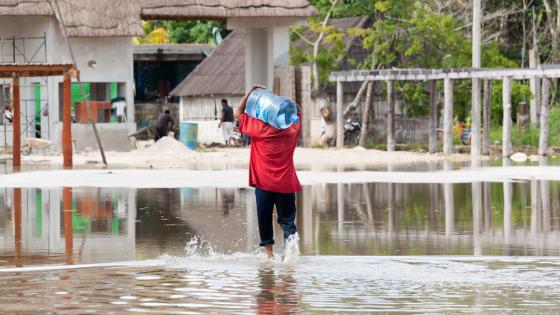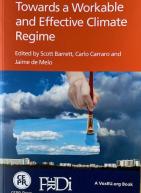The Trump administration’s denial of climate change slowed down international progress at a critical juncture. But not all failure to act can be laid at the door of one country. The international community as a whole abandoned the commitment to cap the increase in the average global temperature to 1.5°C (Intergovernmental Panel on Climate Change 2018). One critical reason is that while all of humanity will be affected by climate change, the initial impact is highly differentiated.
Many see climate change as a future threat, not a present reality. Meanwhile, those that climate change has already hit hard are falling under the radar. Old measures of vulnerability focus on past income per capita levels. We don’t need a new reason to deviate from conventions that hinge on gross national income per capita (Coyle 2014), but measures of past income per capita do not transform well onto the present likelihood of a future climate disaster that destroys lives and livelihoods. By using these old conventions, less than 15% of US overseas development assistance earmarked for climate mitigation went to those countries that are extremely vulnerable to climate change (UNDESA 2015). Neither the OECD nor IMF explicitly includes vulnerability to climate change as a priority (OECD 2015).
We need a new classification of vulnerability – one that is focused on the likelihood of a substantial loss and damage from climate change. Not only will this better target support to where it can make the most significant difference, but highlighting present loss and damage will help to shake the world out of a dangerous complacency. And this must be coupled with policies that are more focused on where the vulnerability lies and building resilience, some of which I describe below.
Higher temperatures will first become insufferable where it is already warm. Warming will initially benefit places that are currently cold.1 And because of the earth’s rotation, when the polar ice caps melt, sea levels will rise near the equator (Spade et al. 2013). North of the Tropic of Cancer and south of the Tropic of Capricorn, the horror of climate change is forecast, not current, and based on models and theories few understand. Consequently, the sense of urgency is not there from those who need to make a difference today.
The frontline in the war against climate change currently lies between the tropics. That is where sea levels have risen the highest, increasing temperatures do the greatest harm, and flooding, droughts, or forest fires have intensified the most. Extreme weather events caused $320 billion of losses and damage around the world in 2017, but $215 billion, or 67%, occurred in the Atlantic hurricane belt, with a country like Dominica losing 226% of GDP in a few hours (Löw 2018). Climate change is the lived reality for these places; denial is rare.
For those on the frontline, there is a nasty nexus between climate change and debt. The cost of environmental damage, the loss of revenues from a natural disaster, and the high price of building back better is a contributor to higher debt (Stiglitz and Rashid 2020). It is no surprise that the countries defined as the most environmentally vulnerable by the UN Environment Programme and others have the highest debt levels.2
While it would be wrong to suggest that they have no choice or policy space, these countries are caught in a vicious cycle. Climate-change vulnerable countries have been using debt to absorb the impact of external shocks and natural disasters. The role of the state as a shock absorber is particularly acute in small states. When a disaster strikes there is no place to hide – hurricanes are many times wider than most small island developing states – and the depth and absorptive capacity of the private sector in small places are thin (Acevedo et al. 2013). Debt-constrained fiscal policy severely limits investment in resilience.
All this leaves these cou,ntries exposed to large-scale natural disasters that put at risk their environmental, economic and social viability. This genuine risk lowers their credit rating more than high debt levels on their own would justify (Moody’s 2016), increasing the cost of external financing for resilience building and narrowing the fiscal space further.3
We propose three ways to break the climate-debt nexus.
1. Redistributing special drawing rights using a new classification of vulnerability
First, countries that have suffered substantial loss and damage from a climate event need immediate and cheap liquidity.
The Trump administration blocked the special drawing rights (SDR) allocation last year, despite efforts by IMF Managing Director Kristalina Georgieva and other proponents. The G20 has now agreed to a new allocation of special drawing rights. While the precise scale of the new allocation has yet to be agreed upon, it is likely to be above $500 billion but below $650 billion – the total value of IMF quotas – as that would require approval from the US Congress which would delay or derail the decision.
The newly issued special drawing rights will be allocated according to IMF quotas, meaning that the entire emerging and developing world would receive less than the combined quotas of the EU, UK, and US, who do not need it. Still, $500 billion is not to be sniffed at. It is twice what was issued in 2009 and can boost reserve assets significantly, even in small developing countries.4 But we need a mechanism that will redistribute special drawing rights from those that do not need them to those that do.
We propose that the world’s strongest economies, led by the US, lend the new SDR allocation to an IMF-administered global disaster mechanism. The global disaster mechanism will provide immediate, unconditional liquidity to those countries suffering loss and damage greater than 5% of GDP on the independent declaration that a climate or natural disaster event has occurred. Today, natural disasters must include pandemics, and the global disaster mechanism should be able to refinance the additional debt incurred during COVID-19 for the countries impacted by more than 5% of GDP (Djankov and Panizza 2020).
Rightly or wrongly, creditors will feel more comfortable with the special drawing rights being managed by an IMF trust. Lending could be capped at a particular multiple of IMF quotas and on floating money market rates with no fixed repayment period. Currently, middle-income countries that are extremely vulnerable to climate change have limited access to concessional financing like the Rapid Credit Facility, and even the less concessionary Rapid Financing Instrument limits funding to only 60% of the quota. This is woefully mismatched to the potential scale of a climate disaster. The global disaster mechanism would be more fit for purpose: targeted to vulnerability, fast, substantial, cheap, and unconditional.
2. Innovation in lending instruments by the multilateral development banks
At times like these, the private sector pulls in its horns and the only ones with an appetite to lend are the multilateral development banks (MDBs). And while the MDBs think of themselves as highly innovative, borrowers are not always so convinced. One fast way MDBs can provide needed liquidity in a crisis is by writing natural disaster clauses in their lending arrangements.
Barbados is now the world’s largest issuer of sovereign bonds with natural disaster clauses. The external bonds have been trading with these clauses for over a year without signs of any ‘cost’. (We understand, however, that natural disaster clauses probably improve the credit quality of a sovereign-issued instrument in a way that would not translate to an MDB.)
Under the Barbados version of these clauses, when an independent agency makes the declaration of a natural disaster, there is an immediate two-year suspension of debt servicing. The maturity of the instrument is then automatically extended for two years. In Barbados’s case, this allows 7% of GDP to be redirected to relief and reconstruction costs. The Barbados clauses inserted in 2019 did not include pandemics. We have learned that these clauses should be written more generally to cover other unforeseen disasters while ensuring that the definition is only to cover rare, ‘external’ events.
3. Financing resilience in the world’s most vulnerable countries without adding to their debt
Before a disaster, and hopefully lessening its impact, countries need financing to build resilience. But most don’t have space for more public debt (Ocampo 2021).
The world’s strongest countries, led by the US, should use their unused special drawing rights to recapitalise regional development banks, with the new capital going towards resilience-building projects in the private sector, where the debt sits on the private sector’s balance sheet. These may include public–private partnerships where, for instance, in return for the state playing a convening role, organising and requiring all utilities to underground lines together in the same conduit, the private sector will share the costs amongst themselves.
Maturities of this lending must be commensurate with the long-term returns of these projects. We suggest a definition of a climate-vulnerable country as one facing a high probability that they will suffer a climate event that leads to a loss and damage of greater than 5% of GDP within the next five years.
While these three proposals require no new budgeted resources from the world’s strongest economies, they offer substantially more emergency liquidity and will build targeted resilience without adding onerously to already high debt levels. They may help to loosen the dangerous nexus between climate and debt.
References
Acevedo, S, A Cebotari and T Turner-Jones (2013), “Caribbean small states: Challenges of high and low growth”, IMF.
Coyle, D (2014), “Measuring economic progress”, VoxEU.org, 17 February.
Djankov, S and U Panizza (2020), “COVID-19 in developing economies”, VoxEU.org, 22 June.
IPPC – Intergovernmental Panel on Climate Change (2018), Special report on global warming of 1.5℃, 8 October.
Löw, P (2018). “Hurricanes cause record losses in 2017 – The year in figures”, Munich RE, 4 January.
Moody’s (2016), “Caribbean sovereigns: The silent debt crisis”.
Munevar, D (2018), “Climate change and debt sustainability in the Caribbean: Trouble in paradise?”, background paper, Intergovernmental Group of Experts on Financing Development 2nd session, 7-9 November, Geneva: UNCTAD.
Ocampo, J-A (2021), “Managing developing country debt”, Brookings, 8 March.
OECD (2015), “‘The where’ of development finance: Towards better targeting of concessional finance”.
Pratt, C, U Kaly and J Mitchell (2004), “Manual: How to use the Environmental Vulnerability Index (EVI)”, South Pacific Applied Geoscience Commission Technical Report 383, United Nations Environment Programme.
Spade, G, J L Bamber, R T W L Hurkmans (2013), “The gravitationally consistent sea-level fingerprint of future terrestrial ice loss”, Geophysical Research Letters, 13 February.
Stiglitz, J, and H Rashid (2020), “How to prevent the looming sovereign debt crisis”, VoxEU.org, 3 August.
UNDESA (2015), “Improving ODA allocation for a post-2015 world”.
Endnotes
1 The IPCC pointed out in its 2007 Synthesis Report, supra note 2 (p. 69), that “for increases in global average temperature of less than 1 to 3°C above 1980-1999 levels, some impacts are projected to produce market benefits in some places and sectors while, at the same time, imposing costs in other places and sectors....” There will be benefits to some crops grown where there may be improved water availability, longer frost-free periods and longer growing seasons.
2 In the Caribbean for instance, seven out of ten countries are categorised as having high or extreme environmental vulnerability have a debt-to-GDP ratio of over 60%, which is often considered a threshold for debt sustainability (Munevar 2018). See also Pratt et al. (2004).
3 Munevar (2018) describes this interplay well.
4 Commentators in countries with continuous access to international capital markets think that special drawing rights are meaningless, but as I have seen first-hand, they play an important role in the reserves and borrowing capacity of many developing countries.



